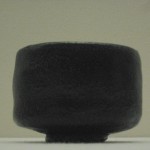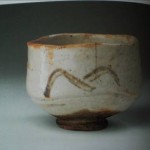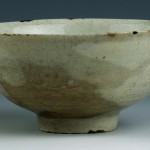my super intense lecture on contemporary asian art and biennales is over… the conference was held… and now i’m up to my ears into chinese archaeology. it’s really interesting, my workflow this semester is like a constant streaming river. never had this before. also, i’m still much into teacup studies for my personal enjoyment. (yeah, the old crusty wound is ripped open again…) finally, i can hold a presentation on some korean teacup with much more ease than ever before. i know where to look for footnotes before i even wrote them down, and i have several concepts in mind that i can attach. it’s great.
i feel quite relaxed, although i should struggle a lot more, as my boyfriend implies… aya…
this time, i am all excited about a korea teapot, the japanese classification is „堅 katade“ (hard), „雨漏 amamori“ (rain-through, darker spots of usage can be seen). i found some interesting information at marshalN’s blog. also, DARUMA mag served me well once again, yay.
Miho (miho.jp) and Nezu (nezu-muse.or.jp) museums both got those styles of teapots.
my new fancy is korean tea… for a first read, i ordered
„The Book of Korean Tea. A Guide to the History, Culture, Philosophy of Korean Tea and the Tea Ceremony“ by Yang-Seok (Fred) Yoo 2007, Myung Won Cultural Foundation, ISBN: 9788995502129
i did not order „The Korean Way of Tea : An Introductory Guide“, by Brother Anthony of Taize and Hong Kyeong-Hee 2007, because it can be found as an online edition: https://hompi.sogang.ac.kr/anthony/kortea.htm
i want to draw some similarities to hagi and karatsu ware, and also take a closer look at ido ware in general since katade-amamoris can be considered a sub group of that…
And I’m craving for the following book, as seen on https://teaarts.blogspot.com, but cannot find one single page to order it… what a shame… maybe it’s too progressive for amazon or what?? oooooo… i so want it >.<*
„中英文“茶学术语“ Chinese-English Tea Studies Terminology
蔡荣章*琼斯史迪芬 编译 Tsai, Rong-Tsang and Steven R. Jones, Translators and Editors (Sep. 22, 2009)
目录Table of Contents
第一章 茶树裁培、采青、初制 Chapter One Tea Cultivation, Tea Harvesting, and Tea
Primary Processing
第二章 茶叶精制、加工、包装 Chapter Two Tea Refining, Added Processing, and Packaging
第三章 茶之分类与识别 Chapter Three Classification and Recognition of Tea
第四章 泡茶原理 Chapter Four Tea Brewing Principles
第五章 十大泡茶法 Chapter Five The Ten Tea Methods
第六章 陶瓷艺术 Chapter Six Ceramics
第七章 茶具名称与功能 Chapter Seven Kinds of Tea Ware and Functionality
第八章 茶会 Chapter Eight Tea Functions
第九章 中国茶史 Chapter Nine Chinese Tea History
第十章 日韩英茶文化 Chapter Ten Japanese, Korean, and British Tea Culture
第十一章 茶诗与健康 Chapter Eleven Tea Poetry and Health
第十二章 茶学综论 Chapter Twelve Tea Studies Review


